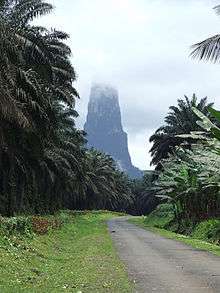Geography of São Tomé and Príncipe




Pico Cão Grande.
São Tomé and Príncipe is a small nation composed of an archipelago located in the Gulf of Guinea of equatorial Atlantic Ocean. The nation's main islands are São Tomé Island and Príncipe Island, for which the country is named. These are located about 300 and 250 kilometres (190 and 160 mi), respectively, off the northwest coast of Gabon in West Africa. The nation's geographic coordinates are a latitude of 1°00′N and a longitude of 7°00′E.
São Tomé and Príncipe constitute one of Africa's smallest countries, with 209 km (130 mi) of coastline. Both are part of an extinct volcanic mountain range, which also includes the island of Bioko in Equatorial Guinea to the north and Mount Cameroon to the west. São Tomé is 50 km (30 mi) long and 30 km (20 mi) wide and the more mountainous of the two islands. Its peaks reach 2,024 m (6,640 ft) - Pico de São Tomé. Principe is about 30 km (19 mi) long and 6 km (4 mi) wide, making it the smaller of the two. Its peaks reach 948 m (3,110 ft) - Pico de Príncipe. This makes the total land area of the country 1,001 km2 (386 sq mi), about five times the size of Washington, D.C.. Both islands are crossed by swift streams radiating down the mountains through lush forest and cropland to the sea. Both islands at a distance of 150 km2 (60 sq mi). The equator lies immediately south of São Tomé Island, passing through an islet Ilhéu das Rolas.
The Pico Cão Grande (Great Dog Peak) is a landmark volcanic plug peak, located at 0°7′0″N 6°34′00″E / 0.11667°N 6.56667°E in southern São Tomé. It rises dramatically over 300 m (1,000 ft) above the surrounding terrain and the summit is 663 m (2,175 ft) above sea level.
Climate
At sea level, the climate is tropical—hot and humid with average yearly temperatures of about 27 °C (80.6 °F) and little daily variation. At the interior's higher altitudes, the average yearly temperature is 20 °C (68 °F), and nights are generally cool. Annual rainfall varies from 5,000 mm (196.9 in) on the southwestern slopes to 1,000 mm (39.4 in) in the northern lowlands. The rainy season runs from October to May.
Wildlife
The two islands are oceanic islands which have always been separate from mainland West Africa and so there is a relatively low diversity of species, restricted to those that have managed to cross the sea to the islands. However the level of endemism is high with many species occurring nowhere else in the world.
Statistics
Maritime claims:
- Measured from claimed archipelagic baselines
- Exclusive economic zone: 200 nmi (370.4 km; 230.2 mi)
- Territorial sea: 12 nmi (22.2 km; 13.8 mi)
- Climate
- Tropical; hot, humid; one rainy season (October to May)
- Terrain
- Volcanic, mountainous
- Elevation extremes
-
- Lowest point: Atlantic Ocean 0 m (0 ft)
- Natural resources
- Fish, hydropower
- Natural hazards
- NA
- Environment—current issues
- Deforestation; soil erosion and exhaustion
- Environment—international agreements
-
- Party to: Biodiversity, Climate Change, Desertification, Environmental Modification, Law of the Sea, Ship Pollution
- Signed, but not ratified: None of the selected agreements
Extreme points
This is a list of the extreme points of São Tomé and Príncipe, the points that are farther north, south, east or west than any other location.
- Northernmost point - unnamed headland on Ilheu Bom Bom
- Easternmost point - Ponta Capitão, Príncipe
- Southernmost point - unnamed headland on Ilhéu das Rolas
- Westernmost point - Ponta Azeitona
See also
| |||||||||||||||||||||||||||||||||||||
| ||||||||||||||